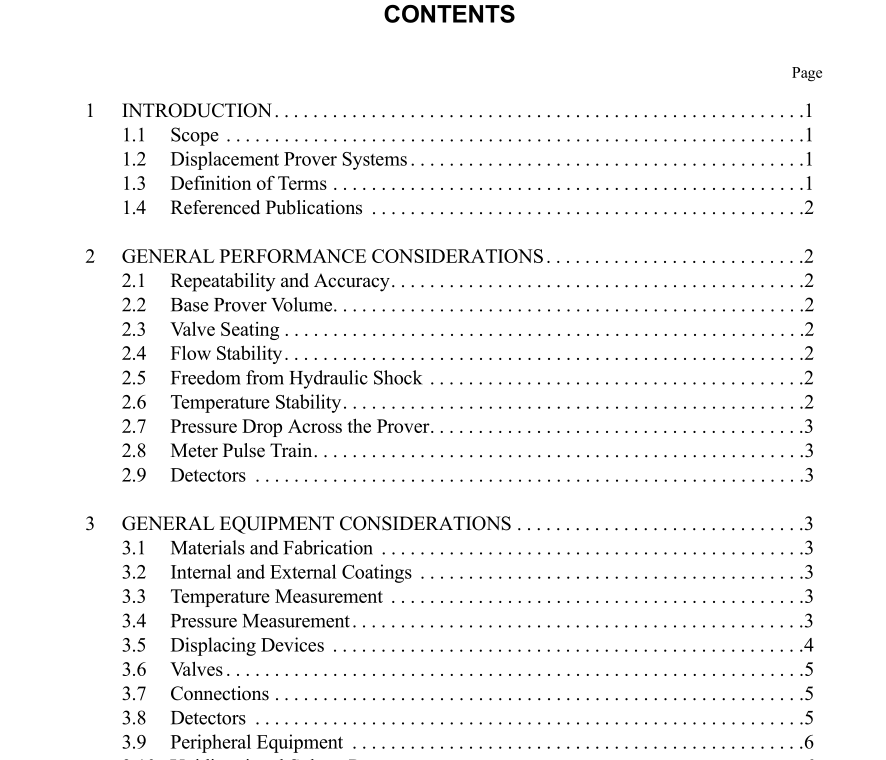API MPMS 4.2 pdf download

API MPMS 4.2 pdf download.Manual of Petroleum Measurement Standards Chapter 4—Proving Systems
1.2 DISPLACEMENT PROVER SYSTEMS
All types of displacement prover systems operate on the principle of the repeatable displacement of a known volume of liquid from a calibrated section of pipe between two detec- tors. Displacement of the volume of liquid is achieved by an oversized sphere or a piston traveling through the pipe. A cor- responding volume of liquid is simultaneously measured by a meter installed in series with the prover. A meter that is being proved on a continuous-flow basis must be connected at the time of proof to a proving counter. The counter is started and stopped when the displacing device actuates the two detectors at the ends of the calibrated section. The two types of continuous-flow displacement provers are unidirectional and bidirectional. The unidirectional prover allows the displacer to travel in only one direction through the proving section and has an arrangement for returning the dis- placer to its starting position. The bidirectional prover allows the displacer to travel first in one direction and then in the other by reversing the flow through the displacement prover. Both unidirectional and bidirectional provers must be con- structed so that the full flow of the stream through a meter being proved will pass through the prover. Displacement provers may be manually or automatically operated.
2 General Performance Considerations
2.1 REPEATABILITY AND ACCURACY Repeatability of a meter proving should not be considered the primary criterion for a prover’s acceptability. Good repeatability does not necessarily indicate good accuracy because of the possibility of unknown systematic errors. Car- rying out a series of repeated measurements under carefully controlled conditions and analyzing the results statistically can determine the repeatability of any prover/meter combina- tion. The ultimate requirement for a prover is that it proves meters accurately. The accuracy of the proving system depends on the accu- racy of the instrumentation and the uncertainty of the prover’s base volume. The repeatability and accuracy of the prover is established by calibration of the prover. 2.2 BASE PROVER VOLUME The base volume of a unidirectional prover is the cali- brated volume between detectors corrected to standard tem- perature and pressure conditions. The base volume of a bidirectional prover is expressed as the sum of the calibrated volumes between detectors in two consecutive one-way passes in opposite directions, each corrected to standard tem- perature and pressure conditions.The base prover volume is determined with three or more consecutive calibration runs that repeat within a range of 0.02% by one of the three following methods—waterdraw, master meter or gravimetric (see API MPMS Ch. 4.9). For the initial base volume determination of a new, modi- fied, or refurbished prover, more than three calibration runs may be used to establish higher confidence in the calibration. When conditions exist that are likely to affect the accuracy of the calibrated volume of the prover, (e.g., corrosion, coating loss) the prover shall be repaired and recalibrated. For deposit buildup, which can be cleaned without affecting the surface of the calibrated volume, the prover need not be recalibrated. Historical calibration data should be retained and evaluated to judge the suitability of prover calibration procedures and intervals. 2.3 VALVE SEATING All valves used in displacement prover systems that can provide or contribute to a bypass of liquid around the prover or meter or to leakage between the prover and meter shall be of the double block-and-bleed type or an equivalent with a provision for seal verification. The displacer-interchange valve in a unidirectional prover or the flow-diverter valve or valves in a bidirectional prover shall be fully seated and sealed before the displacer actuates the first detector. These and any other valves whose leakage can affect the accuracy of proving shall be provided with some means of demonstrating before, during, or after the proving run that they are leak-free.









